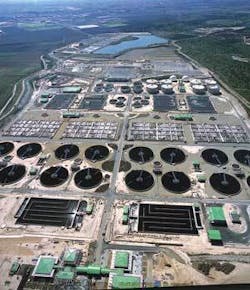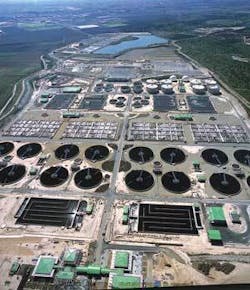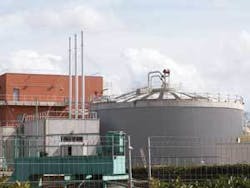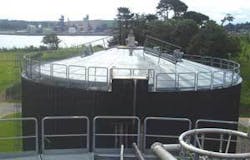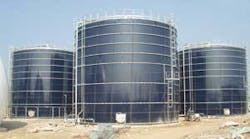Municipal sludge digestion attracts interest as energy prices rise
Anaerobic digestion is recognized as an environmentally sustainable sludge management technology that can reduce sludge organic matter by up to 50% and help wastewater treatment plants achieve energy self-sufficiency - a significant benefit in a world of rising energy prices.
Wastewater sludge stabilization, using anaerobic digestion, is one of the most powerful cell destroyers in the biological world that is used to eliminate large quantities of organic matter (OM). Also known as methane fermentation, this process can reduce OM content of mixed sludge by 40 to 50 percent. It stabilizes sludge by mineralizing volatile content, reduces sludge quantity and odor emissions by using biogas for energy production.
First implemented in Exeter, UK in 1885, the technology and its benefits have been well known for more than 100 years. Demand for this sludge treatment solution remained weak for the past decade due to the incertitude linked to the use of sludge in agriculture. Other technologies such as sludge drying, incineration, and even gasification were preferred to anaerobic treatments. But nowadays, increasing energy costs and the introduction of Green electricity certification in Belgium, Germany and the UK, are driving the choice once more towards anaerobic treatment of sludge.
The French company Degrémont designed and built numerous digesters during the past years; its most famous and largest facility is La Farfana wastewater treatment plant in Santiago, Chile, that includes eight 15,000-m3 digesters. The company also installed anaerobic digesters in wastewater treatment plants in Gabal el Asfar, located in Cairo, Egypt. Digesters are also under construction or being commissioned in Samra, Jordan; Tripoli, Lebanon; and in Tour and Sallanches, France.
Digestion can be a necessary step of treatment prior to drying and incineration because it significantly reduces mass, thereby optimizing post-treatment operations, and offers important cost savings in energy by using combined heat power (CHP).
Indeed, prior to sludge dewatering, digestion reduces the value of volatile solids in sludge, which eases dewatering. An improvement of 0.5 to three points in dryness could be expected compared with fresh sludge dewatering. Consequently, lower sludge quantity also reduces the consumption of polymer, lime and electricity, and the emission of odors in the dewatering building. This option was chosen in Cholet, France, for the 116,000 people equivalent (pe) wastewater treatment plant where two digesters of 3,000 m3 treat a mix of primary and biological sludge, and deliver a sludge dryness of about 28 percent after the centrifuge.
The addition of lime increases dryness and brings alkalinity to acid soils. For example, the refurbished 400,000-pe wastewater treatment plant in Tours, France, will employ three new digesters of 4,500-m3 capacity. Each will treat 18 tons of dry solids per day when commissioned in 2006, whereas lime is now added after centrifugation and before use in agriculture depending of the soil requirement in alkalinity: 20 percent of lime is added for the agricultural use of sludge in south part of Tours and 30 percent of lime is added for the agricultural use of sludge in the northern part of Tours.
Sludge pre-treatment benefits
Since digestion reduces sludge quantity, the first significant benefit of digestion on thermal drying is that it optimizes the dryer size and reduces energy consumption and the quantity of water to be evaporated. Moreover, the excess biogas produced by digestion can also be used to supply thermal energy required by the dryer, which results in significant energy cost savings.
Lastly, digestion makes drying become more reliable. Sludge quality at the entrance of the dryer is constant and homogeneous because sludge remains in the digester for 20 days. Reliability in sludge quality is beneficial because thermal dryers are sensitive to variations in sludge characteristics. Another benefit to coupling anaerobic treatment and thermal drying is the reduction of odors during the drying step of the plant compared to the drying of fresh sludge.
The wastewater treatment plant in Limoges, France, illustrates this type of application. Its wastewater line uses the activated sludge process to treat the equivalent pollution of 285,000 people. Two digesters of a global volume of 6,600 m3 treat sludge before a Centridry drying step supplied by Degrémont. Biogas, produced at the plant, supplies part of the energy required for drying.
Degrémont is also commissioning a wastewater treatment plant in Warsaw, Poland, that treats a peak flow of 112,000 m3 of wastewater per day. A mix of primary and biological sludge is treated in three 8,000 m3, then fed into an Innoplana thermal dryer. Biogas produced by digestion heats the digester and dryer.
Degrémont commissioned a 415,000-pe wastewater treatment plant in Cork, Ireland, in 2004 with three digesters in which digested sludge is dried in another Innoplana thermal dryer. In these plants, digesters are heated either by low-grade heat recovered from the drying plant, by a dedicated boiler, or by a combination of these two heat sources. In normal operating conditions, the energy recovered from the dryers is higher than the energy needed by digesters.
Production of biogas is enough to feed the thermal oil boiler that heats the first thin film evaporator stage of the Innodry dryer. The thermal oil boiler can also use natural gas instead of biogas when the load varies.
Similar to thermal drying, anaerobic digestion helps optimize the use of equipment by reducing the necessary size of the sludge incinerator. In addition, it reduces the amount of water to be evaporated, which translates into less energy consumption and less flue gas to be treated at the outlet of the incinerator. This last point is very important due to the high costs of complying with regulations on flue gas emissions.
Degrémont is constructing a wastewater plant in Tripoli, Lebanon, that will treat wastewater from 997,000 inhabitants. Equipped with a CHP to transform biogas into heat and electricity, its three 10,000-m3 digesters will produce 1.5 electrical MW from biogas. The 39 tons per day of digested sludge at 27 percent dryness mixed with a quantity of 655 tons per year of grease will be incinerated, with a self-sustaining combustion reaction of incineration.
Energy savings
Energy recovery by Combined Heat Power is the second main advantage of digestion, especially since the cost of energy has risen to record levels. Degrémont customers are increasingly selecting this technology to achieve full or partial energy sufficiency; for example, the public wastewater authority Régie Autonome des Eaux et de l’Electricité du Maroc (RADEEMA) chose this technology for the Marrakech wastewater treatment plant in which primary sludge is digested and biogas is supplied through a CHP. The plant generates enough electricity for the needs of the total wastewater treatment plant in normal operating conditions.
The Gabal wastewater treatment plant in Egypt treats a capacity of 500,000 m3 of water per day and is equipped with eight primary digesters, each 9,760 m3, and two secondary digesters, each 8,750 m3. Actual sludge production to be digested is 147 tons dry solids per day. With this quantity of sludge, biogas production ranges between 45,000 and 49,000 Nm3 per day. The plant’s five CHP engines, each 2,320 kva, produce 77,350 kwh of electricity per day using biogas. This amount represents half of the electricity required to operate the entire wastewater treatment plant, a savings of some 450,000 euros per year.
Conclusion
For ages Degrémont has been constructing a wide range of wastewater treatment plants, including the digestion of primary and mixed sludge to stabilize sludge, reduce sludge quantity and odor emissions, but also to optimize the capital expenditures for sludge post-treatment. As an operator of wastewater plants, Degrémont also promotes digestion in order to optimize operational expenditures especially in countries with high electricity rates. Municipal sludge digestion reduces the use of non-renewable energy, carbon dioxide and methane emissions by lowering the volume of sludge transported, stored or sent to landfill. For these reasons, anaerobic digestion has become recognized as an environmentally sustainable, sludge management technology.
Author’s Note
Françoise Petitpain is a marketing manager for Degrémont, based in Rueil Malmaison, France.
Bibliography:
• La digestion anaérobie des boues urbaines- état des lieux, état de l’art SOLAGRO
• Energy price rises fuel advanced digestion. World Water & Environmental Engineering Magazine March/April 2006
About digestion*
Clearly, biological stabilization is only used on sludge that has a high biodegradable matter content (usually higher than 60 percent of DS), i.e. primary sludge (sludge delivered from urban wastewater settling), biological sludge (excess activated sludge, bacteria bed sludge, sludge produced by washing biofilters), mixed sludge (a combination of the two above sludges), and extended aeration sludge (low loading sludge produced by aerobic biological treatment without primary settling).
Fresh sludge from urban effluent is grey or yellowish; it contains fecal matter, vegetable waste, and fibers. It stinks. Sludge that has been completely digested is black (iron sulphide) and gives off a slight tar-like odor. It is virtually impossible to distinguish their original constituents (with the exception of hair, fur, some seeds and plastic waste), 90 percent of salmonellae and most pathogenic germs are destroyed but virus and helminth egg elimination seems less satisfactory. If digested sludge is handled out in the open, this does not create any greater nuisances and fermentation does not appear to resume even after prolonged storage.
Gas output is the most representative and simple criterion for assessing the quality of the digestion. It mainly depends on temperature, contact time and the stabilization level of the VM that undergoes digestion. A properly balanced digestion system will produce 900 to 1 100 L of gas for each kg of VM destroyed. The gas mainly consists of CH4 (60 to 65 percent v/v) and of CO2 (35 to 40 percent v/v). Clearly, its net calorific value will depend on its proportion of CH4. This proportion will range from 21 300 to 23 400 kJ·Nm-3 (5 100 to 5 600 kCal·Nm-3).
Satisfactory digestion operation depends heavily on temperature: start-up speed, stable fermentation, and gas production. In addition to temperature, contact time (based on the daily incoming flow of fresh sludge) and the organic loading applied are essential dimensioning elements.
Additional parameters enhance sludge digester operation and performance: mixing intensity, even feed, VM content, nature and structure.
To prevent foaming, one of the main malfunctions encountered in a digester alongside random incoming air, one should prevent the presence of filament-forming bacteria (Nocardia, microtrix…) in aeration tanks, but also loading or flow rate surges, excessively high temperatures (>40° to 50° C), VFA-rich sludge that has already undergone significant fermentation, and the presence of surfactants that are poorly or badly degraded in the water treatment line.
To prevent struvite precipitation, attention must be paid to the pH and iron salts to block the phosphates (FePO4) must be injected.
In order to improve anaerobic digestion performance by mainly eliminating greater amounts of organic matter and increasing biogas output (in situ recycling), enhancing reaction kinetics and reducing reactor capacities to lower investment costs, thermal, enzymatic, and chemical/mechanical pre-treatment may be implemented.
* Extract from the new Degrémont Water treatment handbook that will be available by September 2006.
